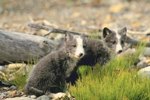
Secretive and elusive, the leopard is one of the fastest, strongest climbers of all the large cats. A leopard is even capable of killing prey much larger than itself. With beautiful golden coats speckled with black rosettes, these fierce predators prowl the African continent in search of their next meal.
Habitat
Leopards live in a wide variety of habitats throughout Africa: woodlands, grassland savannas, forests, mountains, semi-deserts and deserts, though they’re most successful in grasslands and the African savanna. Leopards inhabit areas from sea level all the way up to 5,638 meters on Mount Kilimanjaro. Though adaptable to many climates and elevations, leopards do have a preference for trees wherever they live.
Hunting Practices
Trees play a necessary role in a leopard’s feeding practices. These solitary, mainly nocturnal hunters like to ambush their prey, pouncing before it has a chance to react. Once caught, leopards will break their prey’s neck, and then suffocate it. Afterward, they like to carry their food to a secluded location, usually near a tree or even up a tree, and feed on it over the course of a few days. This serves a couple important purposes: the rotting carcass attracts other potential prey, and the height of the tree keeps the meal safe from hyenas and lions. Leopards are also known to hoard food and may continue hunting and catching prey even though they’ve just had a meal.
A Diverse Diet
Leopards are natural carnivores, but their diet can range from rodents to baboons and antelopes. They typically prey upon midsize mammals like antelopes, gazelles, deer, pigs, primates and domestic livestock. They’re opportunistic, adaptable hunters and can subsist on birds, reptiles, rodents and even arthropods if food is scarce. Leopards hunt and live alone, preferring not to scavenge from other animals like cheetahs and hyenas, though it is occasionally necessary.
Competition for Food
Leopards, lions, spotted hyenas and African wild dogs all have similar diets and geographic range, which means they must compete with each other for food. In severe cases of food shortage, they may even find themselves as prey instead of predator. All of the animals that leopards compete with for food -- lions, spotted hyenas and African wild dogs -- are capable of killing cubs and even adult leopards. The cubs are usually hunted as food, while adult leopards are typically killed due to territorial confrontation.
References
Photo Credits
-
Jupiterimages/Photos.com/Getty Images
Writer Bio
Christina Stephens is a writer from Portland, Ore. whose main areas of focus are pets and animals, travel and literature. A veterinary assistant, she taught English in South Korea and holds a BA in English with cum laude honors from Portland State University.



